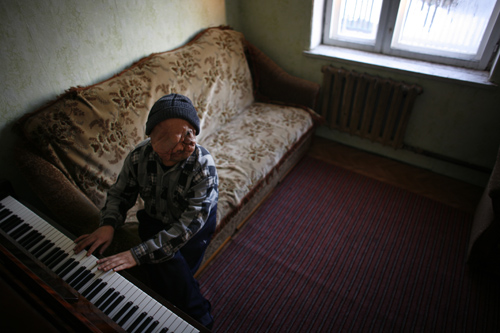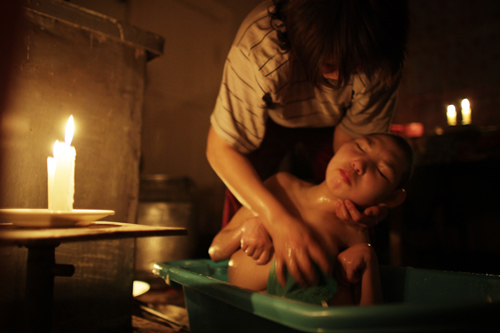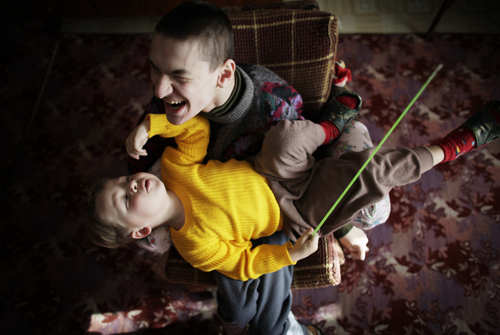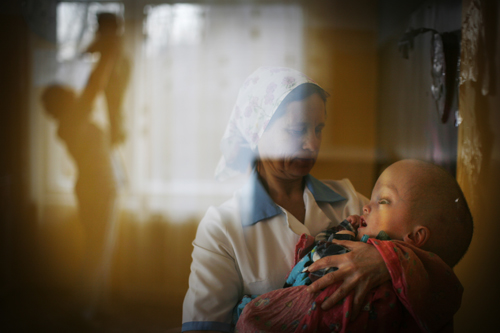
The sun sets over Semey, Kazakhstan. The Semipalatinsk Nuclear Polygon was the site of over four hundred nuclear weapons tests during the Cold War. People living nearby were given virtually no warning of the dangers of radiation. The United Nations Development Programme says that over a million people were exposed to nuclear radiation over the forty years of testing.
Two hands reach out for the ivory of an upright piano. The pianist runs his fingers over the black and white keys, turning his hands in search for the right notes. His ears pique as he finds the sound he is looking for. As he begins to play, his fingers recall fragments of a melody he once heard. The music carries him to some soothing memory, but nobody can see his smile because Berik Syzdykov was born without a face. His deformities and blindness are just one example of the rampant birth defects and illness believed to have resulted from decades of radiation exposure from Soviet nuclear testing.
The earliest detonation of a Soviet atomic bomb, codenamed First Lightning, occurred at the Semipalatinsk Test Site on August 29, 1949, barely four years after the horrors at Hiroshima and Nagasaki. During the remainder of the Cold War, the Semipalatinsk Nuclear Polygon, an area covering 18,500 square kilometers on the steppe of northeast Kazakhstan, was the center of the Soviets’ secret testing program. In all, over four hundred atmospheric and underground nuclear detonations were carried out there over a period of forty years.

- Berik Syzdykov, twenty-nine, sings and plays piano in Semey. Berik was born deformed and without eyes due, doctors say, to prenatal radiation exposure.
Locals were used as guinea pigs to test the effects of radiation on human populations. Doctor Nailya Chaizhunusova from the Scientific Research Institute of Radiation, Medicine, and Ecology tells me, “The army experimented on civilians. They would move people close to the test sites, leave a hundred people in the village, give a test group 200 grams of vodka to drink, and monitor their health after they detonated a nuclear weapon.” The military prohibited doctors from attributing the sharp rise in illnesses and deaths from cancer, leukemia, and radiation exposure in the region to the nuclear tests.
Seventy-year-old Sovietia Mukhamadiyev describes witnessing nuclear blasts as a child. “We were told to hide under a rug,” she says. “The noise was deafening. The explosion was like a sphere, huge, like a cloud. We were told not to look at it, but we couldn’t resist—we were children. It was loud, as if two mountains collided. We were frighteningly close. Rooms shook and buckets turned upside down. All animals, cows, dogs made noise; they didn’t know where to hide. When we were young we didn’t understand that it could be harmful.” Later in life, Sovieta would go blind and lose her husband and three of her children to cancer.
Inside the Nuclear Polygon stand the empty shells of buildings, towers, and structures built to test the destructive potential of nuclear explosions on an American city. A tunnel modeled on specifications of a typical subway station lies underground. But everything is abandoned. Only the frenetic chirp of a Geiger counter warns of radiation levels so high that scientists hesitate to go there. Yet, almost two million villagers spend their entire lives in and around the affected area—drinking ground water, growing crops, and grazing their livestock. Signs warning of radiation were long ago torn down by scavengers and sold as scrap metal.
Radiation has silently devastated three generations of people in Kazakhstan, causing thyroid diseases, cancer, birth defects, deformities, and cardiovascular diseases. Even though nuclear testing ended twenty years ago, life expectancy in the area remains seven years shorter than the national average of Kazakhstan.
Berik Syzdykov takes his hands off the piano and reaches out for someone to take him back home. Berik has been to Italy twice for operations on his face and surgeries aimed at restoring his eyesight. It was during a two-month trip to Italy that he first heard opera and fell in love with it. When he returned home, he learned to play the piano and pieces together songs from memory. “It is hard to spend a life in darkness, without light, having to rely on people to help me,” he says.
In a one-room apartment in Semey (the city of Semipalatinsk, renamed in 2007), Mayra Zhumageldina sings as she carries her only daughter to a plastic bucket and bathes her in the candlelight. Mayra lived in the Abai district, close to the Nuclear Polygon, where she was a witness to years of underground nuclear weapons tests. Her daughter Zhannoor was born with microcephalia and severe scoliosis. She has diminished brain development and cannot speak or perform basic functions. Zhannoor spends her life in her mother’s arms. In sixteen years, Mayra has never left her daughter’s side. “I need to be with her every day. If I leave her alone for more then a few hours, she could have a seizure or choke on her own tongue. I cannot work, because then there will be nobody to take care of her. I cannot leave her.”
Zhannoor is one of a million people who have been recognized as disabled as a direct result of nuclear tests and now receive a monthly stipend from the government. Mayra says the assistance does little to ease their hardship. “What good is money if my daughter cannot think for herself, speak, or go to school? This is what the polygon has done to us.”
Mayra bathes her daughter every night before bed. She massages her body to relax her muscles. Mayra sings Kazakh folk songs to her daughter as they fall asleep in each other’s arms. She whispers, “My chicken, my girl,” but Zhannoor says nothing back.
Across town, a family has found a way to communicate with their disabled son. Eighteen-yearold Nikita Bochkaryov sits in front of a computer wearing a helmet with a curved stick attached to it. His arms tense and spasm uncontrollably as he maneuvers the stick on his helmet, typing on the keyboard, letter by letter. Minutes later, he finishes writing the first line of his poem: “I’d like to fall in love, but I have no one to love yet.” He continues, “I’d like to visit another world, but I have no chance. I’d like to find peace, but the time hasn’t come.”

- Mayra Zhumageldina bathes her daughter, Zhannoor, sixteen, who was born with microcephalia. Mayra must bathe her daughter every night, because she cannot afford diapers on the small stipend provided by the government to assist people affected by radiation from Soviet-era nuclear tests.
Nikita was born with Infantile Cerebral Palsy. He cannot speak, walk, or control his limbs. His parents, Sybilla and Andrei have to feed and bathe him. “He is totally dependent on us, but he is also independent in a way that his life takes place in front of his computer.” When he was growing up, Sybilla realized that even though Nikita could not speak, he could think, smile, and move his fingers. They decided to teach him to use a computer. Now, his life exists on the Internet, where he is able to share his stories and poems, and communicate with his loved ones. “When he was growing up, I did not want to accept that he was disabled,” Sybilla says. “Putting him in a wheelchair was a life sentence for me; we can’t take him anywhere in this place. But once he got on a computer, the world opened up for him.”
To this day, there are over a million people living in and around the Nuclear Polygon. Boris Galich, a scientist at the Scientific Research Institute of Radiation, Medicine, and Ecology, worries about the future generations affected by radiation. “The Cold War was a war driven by fear, using words and a buildup of weapons capable of destroying the world. We must learn the lessons of what happened here, so that in the future ordinary people will never be sacrificed for politics and ideology.”
As the sun sets over the Nuclear Polygon, shooting stars streak across the night sky. Orange light from houses dot the edges of the steppe, breaking up the vast emptiness of a land that has witnessed, many times over, the blinding light of mankind’s power to destroy. The Cold War is over, but the radiation of hundreds of bombs tests, set off in preparation for a nuclear war that never came, will linger for hundreds of years to come.

- Nikita Bochkaryov, eighteen, was born with Infantile Cerebral Palsy. Unable to speak or control his limbs, Nikita can use only his nose when he and his brother Daniel take turns pretending they are dogs wrestling each other.

- Nurse Larissa Soboleva holds two-year-old Adil Zhilyaev at an orphanage in Semey. Adil was born blind with Infantile Cerebral Palsy (ICP) and hydrocephalia. He was abandoned by his parents.














